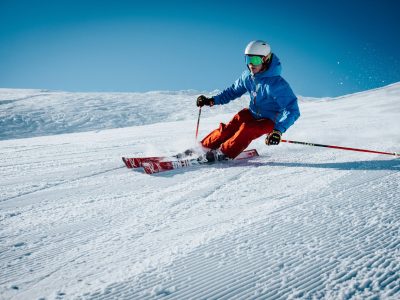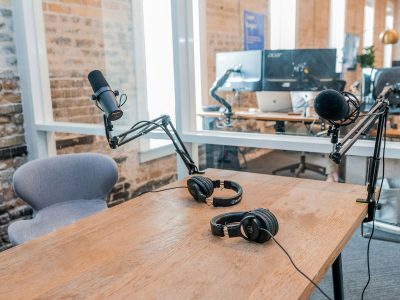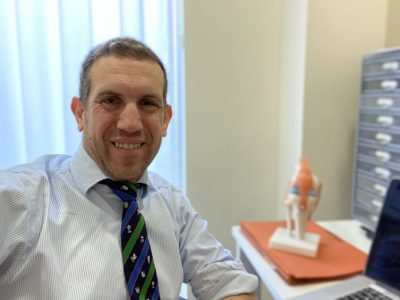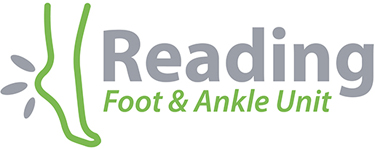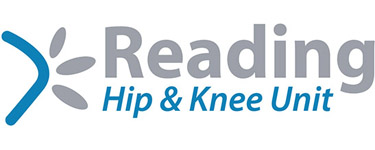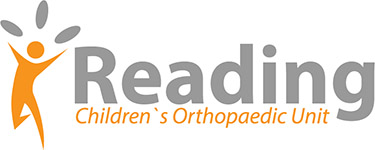Scope – Keyhole Surgery – Knee Arthroscopy
Patient Information Leaflet
Introduction
A knee arthroscopy is a common and useful operation using a ‘keyhole technique’ to look inside the knee joint with a specialised camera, through tiny scars on each side of the knee cap. The first knee arthroscopies were performed in the late 1960s and with subsequent improvements in camera equipment and techniques, it forms the foundation of any knee specialist practice.
The normal knee
The knee is the largest joint in the body, but also the most injured. The main joint itself is made up of two compartments or articulations (medial and lateral) between the lower end of the thighbone (femur) and the upper end of the shinbone (tibia). The knee cap (patella), which slides in a groove on the front of the femur, completes the joint and is often thought of as a separate compartment. Four strong bands of tissue (the ligaments) provide stability whilst allowing a full range of movement. The cruciate ligaments (anterior and posterior or front and back) and the collateral ligaments (medial and lateral or inner and outer) connect the femur and the tibia. Strong thigh muscles (quadriceps / hamstrings) that cross the joint also give the knee strength and contribute to its stability.
There are two types of cartilage within the knee. The surfaces where the femur, tibia and patella touch are covered with articular cartilage, a smooth substance that cushions the bones and enables them to glide freely. Further semi-circular rings of tough fibrous cartilage – called the medial (inner) and lateral (outer) meniscal (shock absorbing) cartilages –– also act as both shock absorbers and stabilisers.
The bones of the knee are surrounded by a thin capsule lined by a membrane known as the synovial membrane. This produces a small amount of special fluid that lubricates the knee, reducing friction to nearly zero in a healthy knee.
Knee Problems
Normally all parts of the knee work together in harmony, but injury (particularly sport related), degenerative changes (arthritis) or weakening of the tissues with age, can cause structural damage within the knee and/or inflammation. This usually results in pain and diminished knee function. Arthroscopy is frequently used to diagnose and treat conditions such as:
- Torn meniscal cartilage (‘shock absorbing cartilage’)
- Loose fragments of bone or articular cartilage
- Damaged joint surfaces (arthritis) or softening of the articular cartilage (chondromalacia)
- Inflammation of the synovial membrane (synovitis) such as rheumatoid or gouty arthritis
- Abnormal alignment (‘tracking’) or instability of the kneecap
- Torn ligaments – including the anterior and posterior cruciate ligaments (ACL & PCL)
Your arthroscopic knee surgery:
What to expect
Almost all arthroscopic knee operations are done as day cases. Mr Davies’ PA Debbie Rollason will contact you about the specific details for your surgery, but usually you will be asked to arrive an hour or two prior to your surgery. Do not eat or drink 6 hours before your surgery.
The day of surgery
When you arrive, you will be checked in by the nursing staff on the day surgery unit. Mr Davies will meet you to go through the consent process and mark the correct leg with an indelible marker pen. The anaesthetist consultant will also meet and assess you and discuss the anaesthetic options. Most of these cases are performed under a general anaesthetic (i.e. you are asleep).
Following anaesthesia, a tight inflatable band (tourniquet) is put round the top of your thigh to limit the amount of bleeding and improve the view within your knee. Mr Davies will make 2 or 3 small incisions (~1cm long) in your knee. A sterile solution is then used to fill the knee joint to allow a clear view. The arthroscope and camera are then inserted to diagnose your problem properly, viewing the pictures on a TV monitor. The second or third incisions allow the introduction of tools such as probes, shavers, or graspers. This part of the procedure usually lasts about thirty minutes.
The surgeon may not be able to say exactly what needs to be done (if anything) until he is looking inside the knee. Therefore, the consent form is often nonspecific.
Common treatments with knee arthroscopy include:
- Removal or repair of torn meniscal cartilage
- Trimming of torn pieces of articular cartilage
- Removal of loose fragments of bone or cartilage
- Removal of inflamed synovial tissue
At the end of the operation, Mr Davies injects the knee joint and the incisions with local anaesthetic (for pain relief). He closes the incisions with sutures and paper suture strips and covers them with a bandage.
You will be moved to the recovery room to wake up where the nursing staff will look after you. Usually, you will be ready to go home later that day, having been seen and advised by the physiotherapist. Most patients are able to walk out without the need for crutches. You will need someone to drive you home that day.
Risks and potential complications of arthroscopic knee surgery
All surgical procedures have small risks. Listed below are some of the problems and risks that can happen with this procedure. These will be discussed with you in more detail during the consent process.
Common Risks / Problems (1-5%)
- Bleeding and Bruising
On occasion some continued ooze may occur from the surgical wounds requiring frequent changes of dressing. This usually settles in a few days and rarely requires any further intervention. - Swelling
The knee may fill with fluid and/or blood. This usually resolves with time but very rarely requires a second operation to drain the fluid. - Developing a lump under the wound
This is caused by a small amount of bleeding and scarring under the skin and normally settles with local massage after a few weeks. - Numbness
The skin around the front of the knee may become temporarily or permanently numb due to damage to some superficial nerve fibres. - Wound infection
The wound sites may become red and hot and there may be a discharge. This usually settles with antibiotics. Very occasionally the infection may spread to the knee joint and a further operation may be needed to washout the joint. - Ongoing Symptoms or Recurrence of Symptoms
Rare (<1%)
- Blood clots (Deep Vein Thrombosis – DVT)
Blood clots after knee arthroscopy are extremely rare. Clots can occur in the veins of the legs and can occasionally move through the blood stream to the lungs (pulmonary embolus). You will be given compression stockings to reduce the risk of blood clots forming. Starting to walk and moving early is also one of the best ways to prevent blood clots from forming. - Unsightly scarring of the skin
Most wounds heal to a neat scar, but some may become thickened and painful (keloid). This is more common in patients with darker skin tones. - Amplification of pain and stiffness (complex regional pain syndrome)
This is extremely rare, the cause of which is unknown and can take months or years to recover.
Your Recovery at Home
Recovery from knee arthroscopy is much faster than recovery from traditional open knee surgery. Still, it is important to follow your surgeon’s and / or physiotherapists instructions carefully after you return home. You will need to make sure that someone is available to be with you that evening. (For Knee exercises post arthroscopy please click here)
Swelling
When you are sitting or lying down, keep your leg elevated as much as possible for the first few days after surgery. Apply ice packs or frozen peas (wrapped in a tea towel) for 10 minutes, every few hours, to help reduce swelling and pain. Please click here about hiring a compression cryocuff (ice duvet) postoperatively.
Dressing Care
You will leave the hospital with a bulky bandaged dressing covering your knee. This crepe bandage can be removed after 48 hours and replaced with a tubigrip support (issued by nursing staff). The tubigrip is to be worn during the day and taken off at night. You may shower after 5 days but should avoid directing water at the scars. Do not soak in a bath. Keep your scars clean and dry until they are fully healed.
Walking
After most arthroscopic surgeries, you can walk unassisted. However, on occasion you may require crutches for a period of time after surgery. You can gradually put more weight on your leg as your discomfort subsides and you regain strength in your knee. You will usually be able to drive after 3-5 days depending on the procedure undertaken. For the first week post operatively limit walking to around the house.
Stairs
The ability to go up and down stairs requires strength and flexibility. At first, you will need a handrail for support and will be able to go only one step at a time. Always lead up the stairs with your good knee and down the stairs with your operated knee (“Up with the good” and “down with the bad”). You may want to have someone help you until you have regained most of your strength and mobility. Stair climbing is an excellent strengthening and endurance activity. Do not try to climb steps higher than the standard height (7 inches) and always use a handrail for balance. As you become stronger and more mobile, you can begin to climb stairs foot over foot.
Anterior knee pain
The majority of patients experience some discomfort around the front part of the knee in the first few weeks after arthroscopic surgery. This is due to a large fat pad – which normally sits just below the kneecap and behind the patella tendon – becoming inflamed as a result of the surgery within the knee joint. It is a self-limiting problem i.e. it will settle spontaneously after a few weeks but will be helped by the post-operative strengthening exercises which are highlighted below. The anterior knee pain may feel like “pressure” on the front part of the knee and can make kneeling uncomfortable for a few weeks. It can also be made worse when walking downstairs and when trying to fully flex (bend) the knee.
Reasonable Expectations after Arthroscopic Surgery
Mr Davies will arrange to see you a few weeks after surgery to check your progress.
Although arthroscopy can be used to treat many problems, you may have some activity limitations even after recovery. The outcome of your surgery is often determined by the degree of injury or damage found in your knee. For example, if you damage your knee during vigorous sport’s activity and the smooth articular cushion of the weight-bearing portion of the knee has been damaged and / or worn away completely, then full recovery may not be possible. Subsequently you may be advised to find a lower-impact alternative form of exercise. A professional athlete often sustains the same injury as a weekend recreational athlete, but the potential for recovery will often be improved by the over-development of their knee muscles. Physical exercise and rehabilitation will play an important role in your final outcome. A formal physiotherapy program will help you to return to your desired activity.
A return to intense physical activity should only be done under the direction of your surgeon and / or physiotherapist.
It is reasonable to expect that by six to eight weeks you should be able to engage in most of your former physical activities provided they do not involve significant weight-bearing impact. Twisting manoeuvres may have to be avoided for a longer time.
If your job involves heavy manual work, e.g. builder, you may require more time to return to full work than if you have a more sedentary job.
For information on exercises to do after your surgery CLICK HERE
If you have any questions please don’t hesitate to contact us!


